2012 Peugeot 508 RXH gearbox
[x] Cancel search: gearboxPage 4 of 304

.
.
Contents
Instrument panel 45
Indicator and warning lamps 46
Gauges and indicators 57
Tr ip computer 62
Setting the date and time 65
Instruments and controlsFamiliarisation
Remote control key 66
Alarm 76
Electric windows 78
Boot 80
Motorised tailgate 81
Panoramic sunroof 84
Fuel tank 85
Diesel misfuel prevention 86
Access
Front seats 88
Rear seats 92
Mirrors 94
Steering wheel adjustment 96
Interior fi ttings 97
Boot fi ttings 100
Heating and Ventilation 106
Dual-zone digital air conditioning 108
Quad-zone digital air conditioning 111
Rear screen demist - defrost 116
Programmable Heating / Ventilation 117
Comfort
Electric parking brake 119
6-speed electronic gearbox 126
Hill star t assist 130
Head-up display 131
Speed limiter 134
Cruise control 136
Parking sensors 138
Parking space sensors 140
Driving
Lighting controls 142
LED lamps 145
Automatic illumination of headlamps 147
Headlamp adjustment 150
Directional lighting 151
Wiper controls 152
Automatic rain sensitive wipers 154
Cour tesy lamps 156
Interior mood lighting 157
Visibility Hybrid system
Presentation 22
Starting / switching off 25
Ready lamp 29
HYbrid4 mode selector 29
Energy consumption / generation indicator 32
Display of hybrid power fl ow 33
Eco off 36
Eco-driving 37
Consumption 39
High voltage battery 40
Vehicle recovery 44
Page 6 of 304

4
Familiarisation
Presentation of the HYbrid4 system
Thank you for choosing this HYbrid4 vehicle,
which has characteristics that are different from conventional vehicles.
Study this handbook to learn about the specific hybrid functions and for more information, refer
to the "Hybrid System" section.
22
The HYbrid4 technology allows two sources of energy to be associated in an effective manner:
the Diesel HDi engine, which drives the front
wheels and the electric motor, which drives the
rear wheels.
These two motors can operate alternately or simultaneously, according to the hybrid modeselected and the driving conditions.
The electric motor alone provides power for
the vehicle in "ZEV" (Zero Emissions Vehicle) mode, and in "Auto" mode for running at slowspeed and low load. It also assists the Dieselengine when moving off, accelerating and changing gear.
The battery that powers the electric motor is
recharged during phases of deceleration andstores the energy for subsequent use.1
.Diesel HDi engine (front wheel drive). 2. Electric motor (rear wheel drive).3.
200 V battery.4.Electronic power supervisor.
5.Stop & Start system. 6
.6 -speed electronic gearbox.7. Electrical flow. 8.HYbrid4 mode selector.
Page 24 of 304
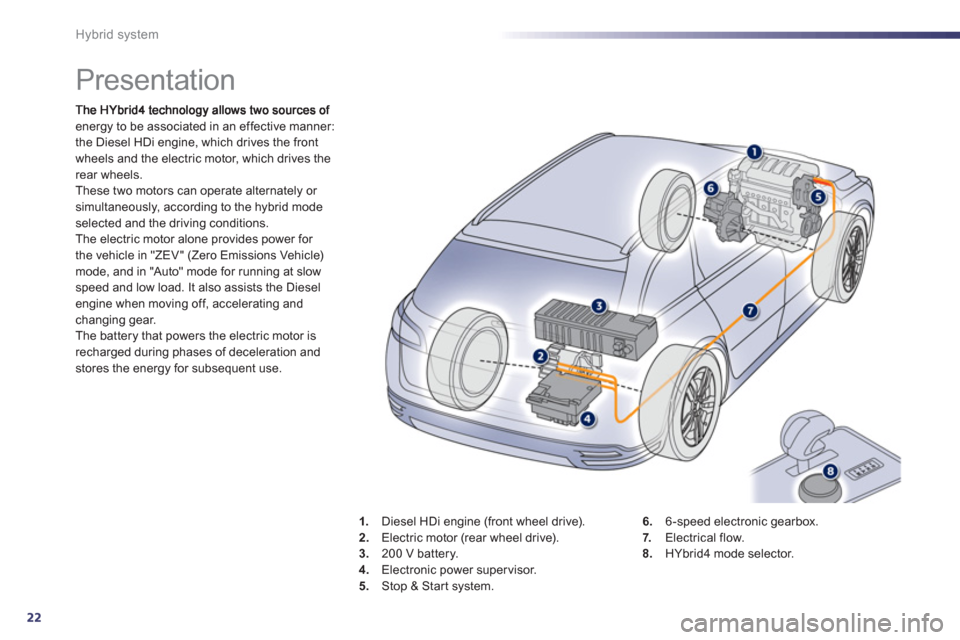
22
Hybrid system
Presentation
energy to be associated in an effective manner:
the Diesel HDi engine, which drives the front
wheels and the electric motor, which drives the rear wheels.These two motors can operate alternately or simultaneously, according to the hybrid modeselected and the driving conditions.
The electric motor alone provides power for
the vehicle in "ZEV" (Zero Emissions Vehicle) mode, and in "Auto" mode for running at slowspeed and low load. It also assists the Dieselengine when moving off, accelerating and changing gear.The battery that powers the electric motor is recharged during phases of deceleration andstores the energy for subsequent use.
1.Diesel HDi engine (front wheel drive). 2. Electric motor (rear wheel drive).3.
200 V battery.4.Electronic power supervisor.
5
.Stop & Start system. 6
.6 -speed electronic gearbox.7. Electrical flow. 8.HYbrid4 mode selector.
Page 26 of 304
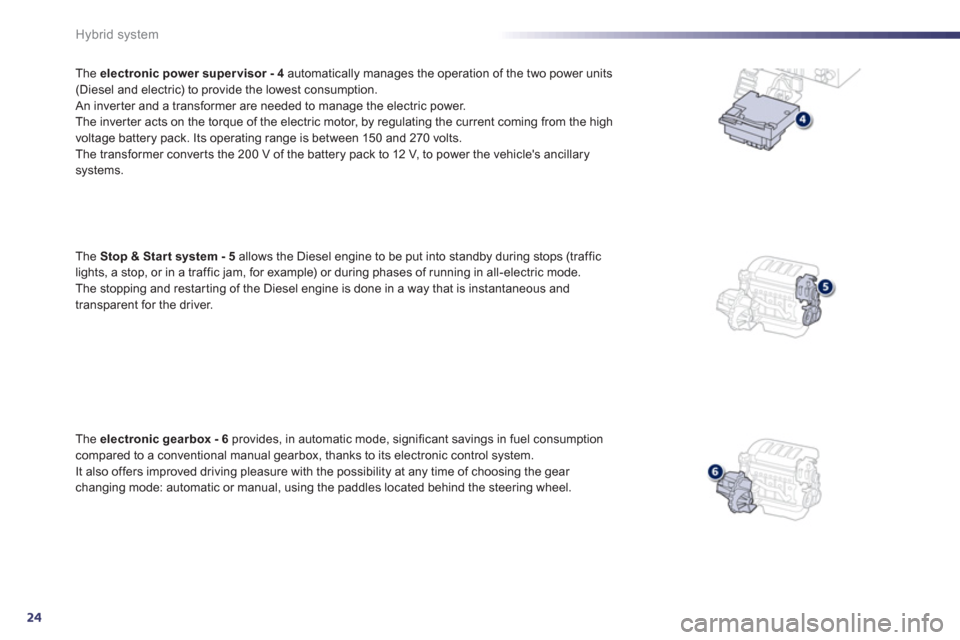
24
Hybrid system
The electronic power super visor - 4automatically manages the operation of the two power units(Diesel and electric) to provide the lowest consumption.
An inver ter and a transformer are needed to manage the electric power.
The inver ter acts on the torque of the electric motor, by regulating the current coming from the high
voltage battery pack. Its operating range is between 150 and 270 volts.
The trans
former conver ts the 200 V of the battery pack to 12 V, to power the vehicle's ancillary
systems.
Th
e Stop & Star t system - 5
allows the Diesel engine to be put into standby during stops (traffic
lights, a stop, or in a traffic jam, for example) or during phases of running in all-electric mode.
The stopping and restar ting of the Diesel engine is done in a way that is instantaneous and
transparent for the driver.
Th
e electronicgearbox - 6provides, in automatic mode, significant savings in fuel consumption compared to a conventional manual gearbox, thanks to its electronic control system.
It also offers improved driving pleasure with the possibility at any time of choosing the gear changing mode: automatic or manual, using the paddles located behind the steering wheel.
Page 33 of 304
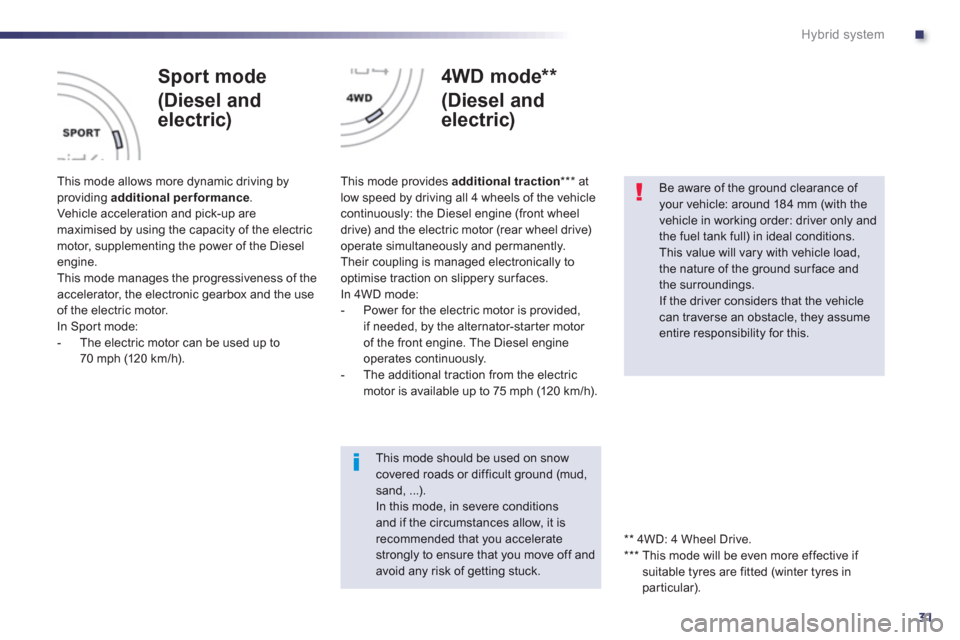
.
31
Hybrid system
Sport mode
(Diesel and
electric)
This mode allows more dynamic driving byproviding additional performance. Vehicle acceleration and pick-up aremaximised by using the capacity of the electricmotor, supplementing the power of the Dieselengine.
This mode manages the progressiveness of the
accelerator, the electronic gearbox and the useof the electric motor.
In Spor t mode:
-
The electric motor can be used up to
70 mph (120 km/h).
4WD mode **
(Diesel and
electric)
This mode provides additional traction*** at low speed by driving all 4 wheels of the vehiclecontinuously: the Diesel engine (front wheel
drive) and the electric motor (rear wheel drive)
operate simultaneously and permanently.
Their couplin
g is managed electronically to
optimise traction on slippery surfaces.
In 4WD mode:
- Power for the electric motor is provided,
if needed, b
y the alternator-star ter motor
of the front engine. The Diesel engine
operates continuously.
- The additional traction from the electric
motor is available up to 75 mph (120 km/h).
This mode should be used on snowcovered roads or difficult ground (mud, sand, ...). In this mode, in severe conditionsand if the circumstances allow, it is recommended that you acceleratestrongly to ensure that you move off andavoid any risk of getting stuck.
Be aware of the ground clearance of your vehicle: around 184 mm (with the vehicle in working order: driver only and
the fuel tank full) in ideal conditions. This value will vary with vehicle load,the nature of the ground surface and the surroundings.
If the driver considers that the vehiclecan traverse an obstacle, they assumeentire responsibility for this.
**
4WD: 4 Wheel Drive.
***
This mode will be even more effective if suitable tyres are fitted (winter tyres in
particular).
Page 39 of 304

.
37
Hybrid system
Eco-driving
Eco-driving is a range of everyday practices that allow the motorist to optimise their fuel consumption and CO2 emissions.
Optimise the use of your
gearbox
Use automated mode Aas much as possible as this optimises gear changes to suit the
circumstances.
Drive smoothly
Maintain a safe distance between vehicles, use engine braking rather than the brake pedal, and press the accelerator progressively. These practices contribute towards a reduction in fuel consumption and CO2 emissions and also helps reduce thebackground traffic noise.
If your vehicle has cruise control, make use of the system at speeds above 25 mph (40 km/h) when the traffic is flowing well.
Control the use of your
electrical equipment
Before moving off, if the passenger compartment is too warm, ventilate it byopening the windows and air vents before using the air conditioning.
Above 30 mph (50 km/h), close the windowsand leave the air vents open. Remember to make use of equipment that canhelp keep the temperature in the passenger compartment down (sun roof and window blinds...).Switch off the air conditioning, unless it has automatic digital regulation, as soon as the desired temperature is attained.Switch off the demisting and defrosting controls, if not automatic.
Switch off the heated seat as soon as possible.
Switch off the headlamps and front foglampswhen the level of light does not require their use.
Avoid running the Diesel engine when stationary, par ticularly in winter; your vehiclewill warm up much faster while driving.
As a passenger, if you avoid connecting your multimedia devices (film, music, video game...), you will contribute towards limitingthe consumption of electrical energy, and soof fuel.
Disconnect your por table devices beforeleaving the vehicle.
Page 47 of 304
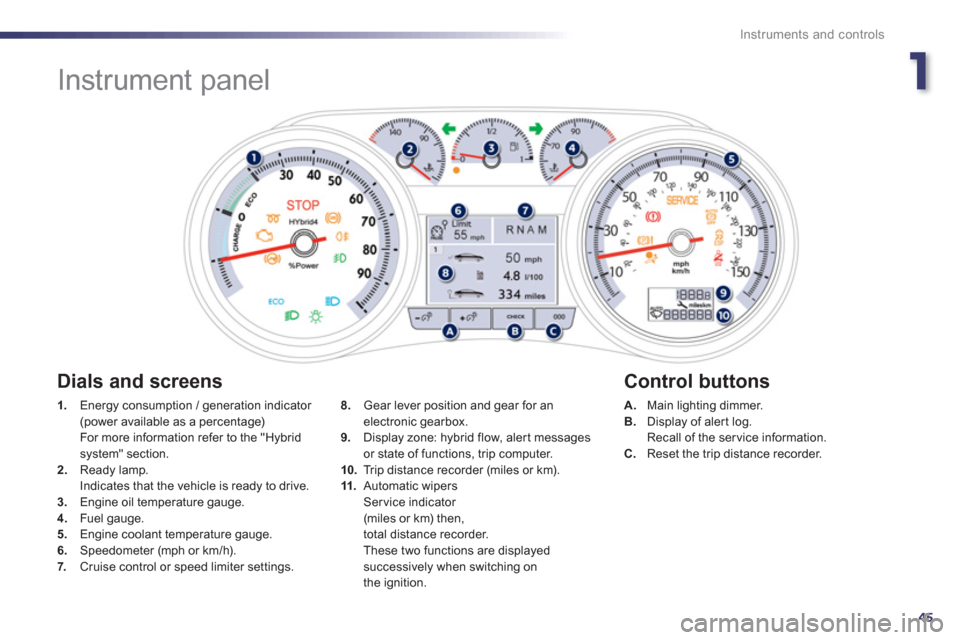
1
45
Instruments and controls
Instrument panel
1.
Energy consumption / generation indicator (power available as a percentage) For more information refer to the "Hybrid system" section. 2.Ready lamp.
Indicates that the vehicle is ready to drive. 3.Engine oil temperature gauge. 4. Fuel gauge.
5. Engine coolant temperature gauge.
6.Speedometer (mph or km/h).7. Cruise control or speed limiter settings.
A.Main lighting dimmer. B.
Display of aler t log.
Recall of the service information.
C. Reset the trip distance recorder.
8.
Gear lever position and gear for anelectronic gearbox. 9.
Display zone: hybrid flow, alert messages
or state of functions, trip computer.
10.Trip distance recorder (miles or km).
11.Automatic wipersSer vice indicator (miles or km) then,
total distance recorder.
These two functions are displayedsuccessively when switching on
the ignition.
Dials and screens
Control buttons
Page 50 of 304
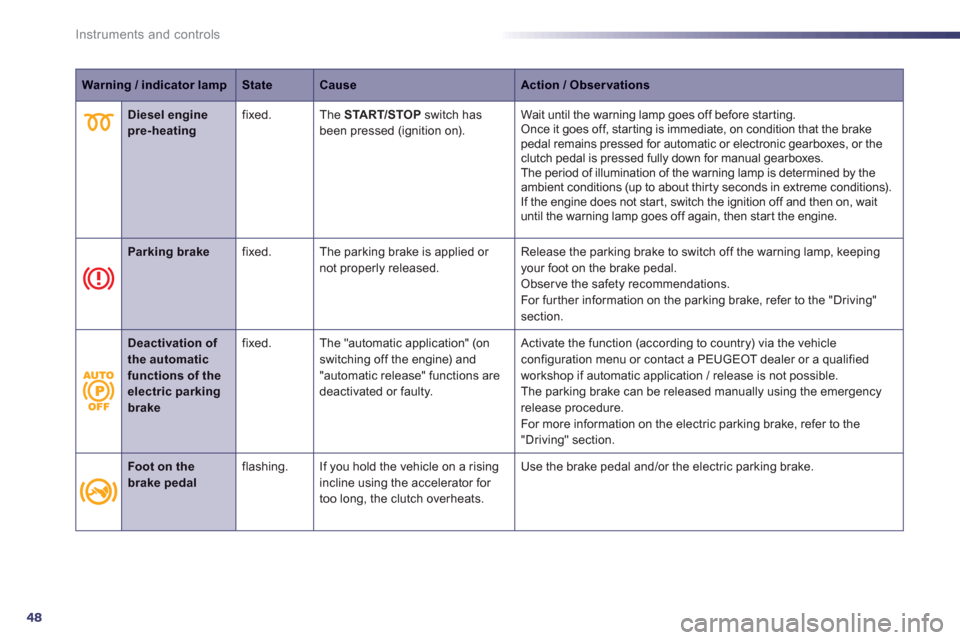
48
Instruments and controls
Warning / indicator lampStateCauseAction / Observations
Diesel engine pre-heatingfixed. The START/STOPswitch hasbeen pressed (ignition on).Wait until the warning lamp goes off before star ting. Once it goes off, starting is immediate, on condition that the brake pedal remains pressed for automatic or electronic gearboxes, or theclutch pedal is pressed fully down for manual gearboxes.
The period of illumination of the warning lamp is determined by theambient conditions (up to about thir ty seconds in extreme conditions).
If the engine does not star t, switch the ignition off and then on, wait until the warning lamp goes off again, then start the engine.
Parking brakefixed. The parking brake is applied or
not properly released.Release the parking brake to switch off the warning lamp, keepingyour foot on the brake pedal. Observe the safety recommendations.
For fur ther information on the parking brake, refer to the "Driving"section.
Deactivation of the automatic functions of the electric parkingbrake
fixed. The "automatic application" (on switching off the engine) and"automatic release" functions are
deactivated or faulty. Activate the function
(according to country) via the vehicle configuration menu or contact a PEUGEOT dealer or a qualified workshop if automatic application / release is not possible.
The parking brake can be released manually using the emergencyrelease procedure.
For more information on the electric parking brake, refer to the "Driving" section.
Foot on thebrake pedalflashing. If you hold the vehicle on a risingincline using the accelerator for
too long, the clutch overheats.Use the brake pedal and
/or the electric parking brake.